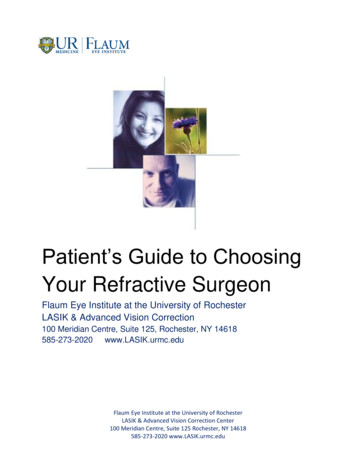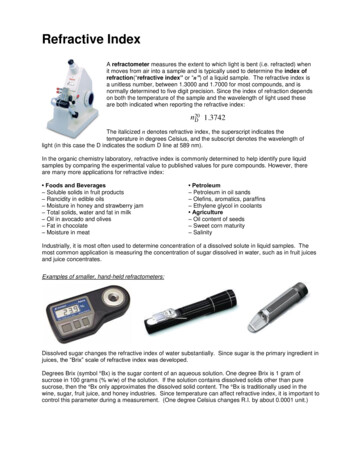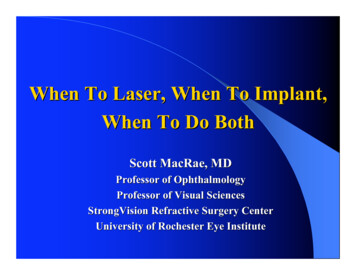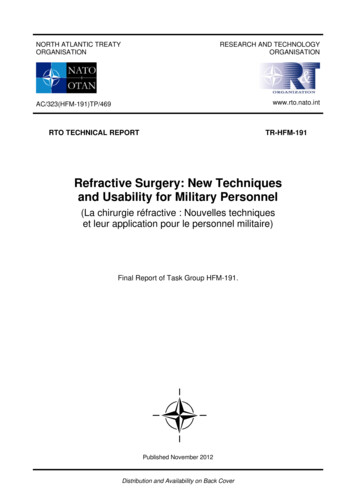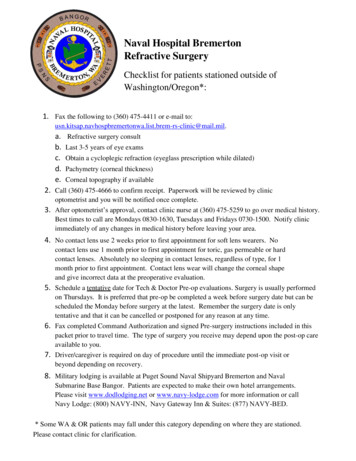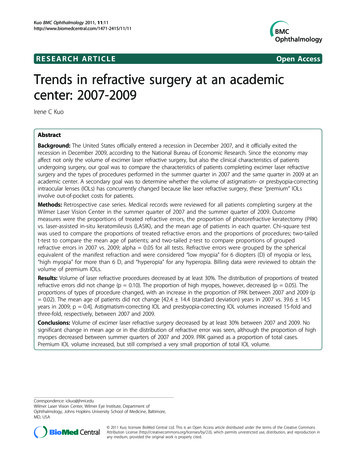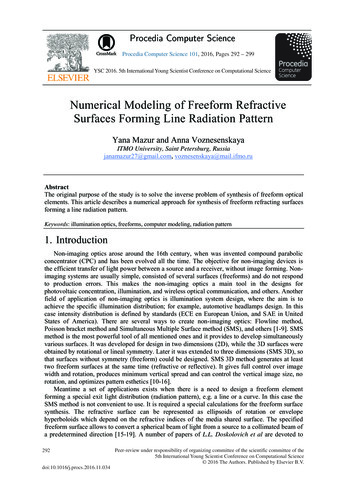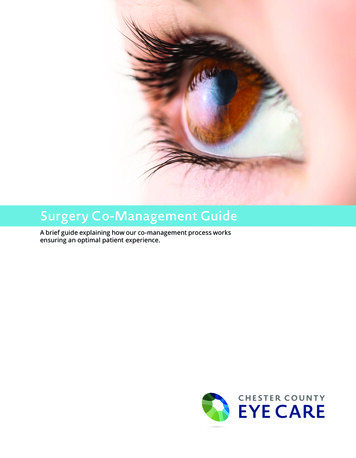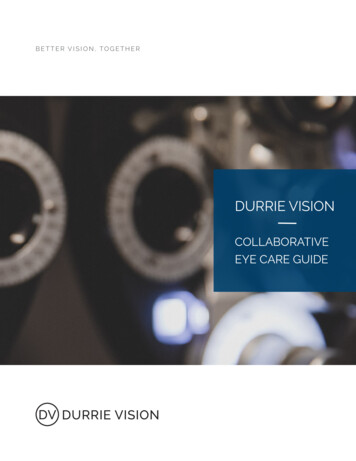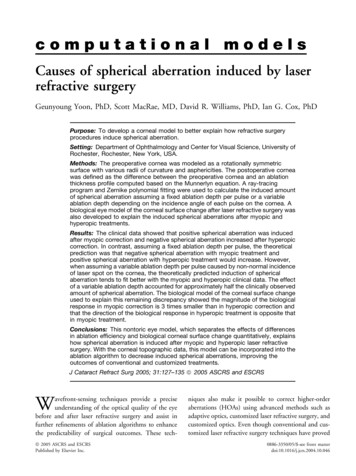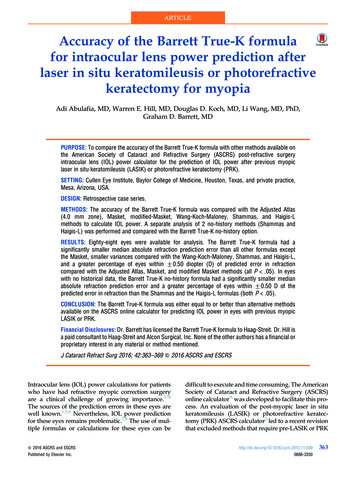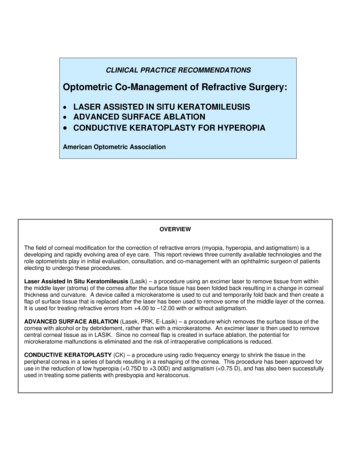
Transcription
CLINICAL PRACTICE RECOMMENDATIONSOptometric Co-Management of Refractive Surgery: LASER ASSISTED IN SITU KERATOMILEUSIS ADVANCED SURFACE ABLATION CONDUCTIVE KERATOPLASTY FOR HYPEROPIAAmerican Optometric AssociationOVERVIEWThe field of corneal modification for the correction of refractive errors (myopia, hyperopia, and astigmatism) is adeveloping and rapidly evolving area of eye care. This report reviews three currently available technologies and therole optometrists play in initial evaluation, consultation, and co-management with an ophthalmic surgeon of patientselecting to undergo these procedures.Laser Assisted In Situ Keratomileusis (Lasik) – a procedure using an excimer laser to remove tissue from withinthe middle layer (stroma) of the cornea after the surface tissue has been folded back resulting in a change in cornealthickness and curvature. A device called a microkeratome is used to cut and temporarily fold back and then create aflap of surface tissue that is replaced after the laser has been used to remove some of the middle layer of the cornea.It is used for treating refractive errors from 4.00 to –12.00 with or without astigmatism.ADVANCED SURFACE ABLATION (Lasek, PRK, E-Lasik) – a procedure which removes the surface tissue of thecornea with alcohol or by debridement, rather than with a microkeratome. An excimer laser is then used to removecentral corneal tissue as in LASIK. Since no corneal flap is created in surface ablation, the potential formicrokeratome malfunctions is eliminated and the risk of intraoperative complications is reduced.CONDUCTIVE KERATOPLASTY (CK) – a procedure using radio frequency energy to shrink the tissue in theperipheral cornea in a series of bands resulting in a reshaping of the cornea. This procedure has been approved foruse in the reduction of low hyperopia ( 0.75D to 3.00D) and astigmatism ( 0.75 D), and has also been successfullyused in treating some patients with presbyopia and keratoconus.
PATIENT EDUCATIONPrior to considering refractive surgery, patients need to be fully informed about the benefits and risks of availableprocedures and be counseled on all available treatment options. The optometrist, as a primary provider of eye and visioncare services, plays a key role in this process. Factors considered in patient education include the following:Realistic Expectations Elective procedure and costsRisks vs. benefitsEnhancement potentialAlternative Corrections SpectaclesContact lensesOther surgical procedures (e.g., Phakic IOLs or refractive lens exchange procedureswith accommodation (Crystalens) or multifocal IOLs)Normal Symptoms and SideEffects DiscomfortDry eye (3 9 months, depending on pre-existing condition)Fluctuating vision (from 4 6 weeks to 3 months, depending on dry eye and otherfactors)Halos and glare at night (4 6 weeks)Foreign body sensation (lasting 24-48 hours)Risk for Complications Intraoperative problemsAbnormal healingCorneal hazeLoss of Best Corrected Visual Acuity (BCVA)Higher-order aberrationsInfectionOther surgical complications like corneal ectasiaPresbyopia Increased dependence on reading glasses in later years when both eyes aresurgically corrected for distanceOptional slight undercorrection of non-dominant eye for reading in patients ofpresbyopic and prepresbyopic ageIntraoperative Role of Patient Maintain fixation on targetPostoperative Eye Care Lubrication, instillation of dropsOral medication, including precautions for use of oral narcotic analgesics andavoidance of alcoholic beveragesDo not rub eyes and wear protective shield at night for first weekFollow-up visitsReporting of symptoms
PREOPERATIVE CONSIDERATIONSThe following factors need to be evaluated prior to refractive surgery as they may lead to potential complicatonsUnstable Refractive Error Age 21 years (some female patients will reach astable refractive error prior to age 21 typically notbefore age 18) Cataract development Corneal warpage secondary to long term contact lenswearCorneal ThicknessPredicted post-operative corneal thickness 410 microns(i.e. 300 microns under the flap)Systemic Disease Uncontrolled diabetes, type 1 (insulin-dependent) oruncontrolled type 2. Rheumatoid arthritis or other autoimmune diseases(e.g., lupus) that are not well controlledLarge PupilsPatients with larger pupils especially in dim illuminationmay be at greater risk of observing higher order aberrationsshould they be present or remain following laser surgery.Patient education and documentation is important.Ocular Disease Keratoconus Pellucid marginal degeneration of the cornea Cataracts Glaucoma manifesting visual field defects Fuchs’ corneal dystrophy Other corneal dystrophy that results in recurrenterosion (e.g., granular or lattice dystrophy) may bebetter served with PRK Non responsive Keratoconjunctivitis sicca (KCS) orsevere dry eye as indicated by patient symptoms andsigns. Corneal staining with a vital dye (e.g., Lissamine green,rose bengal, etc.) grade three and not responding todry eye therapy or Schirmer tear tests 5 mm. Untreated lid disease, e.g., blepharitis or meibomitis High positioned scleral buckles following retinaldetachment surgery Neurotrophic keratitis Herpes simplex virus (HSV) keratitis 12 mo prior tosurgeryPreoperative Keratometry ReadingsA cornea that is too flat or too steep (predictive K readingsfor myopic eyes 36 D may result in poor postoperativeoptics, and for hyperopic eyes 49 D, may result in greaterdry eye symptoms.Unrealistic Expectations Expectation of better than 20/20 vision. Expectation of never needing to use reading glasses.High Refractive ErrorCaution should be taken in hyperopia exceeding 4.00 D ormyopia over –9.00 D in patients not otherwise excluded bypachymetry or pupil size. Lens procedures (e.g., clear lensexchange or phakic intraocular lens (IOL) should beconsidered or discussed for certain patients in thisrefractive error range.
PRE-OPERATIVE EVALUATIONThe pre-operative evaluation procedures for patients considering refractive surgery may include, but are not limited to:Pachymetry(corneal thicknessmeasurement) Postoperative corneal thickness 410 microns.Ablation depth is based on optical zone (OZ) diameter, blend zone (BZ), andrefractive error 15 microns per diopter.Pupil Diameter The patient with larger pupils may be more likely than one with smaller pupils tonotice any existing higher-order aberration, which may manifest as night visionproblem.Measure pupils under both photopic (or mesopic) and scotopic conditions anddocument for dim illumination. Topography Evaluation of surface contour of cornea to determine the potential of earlykeratoconus.Keratometry Preoperative corneal curvature (K readings) and dioptric value of refractive errorpredict postoperative K readings.Manifest/ Cycloplegicrefraction Measurement of refractive error (myopia, hyperopia, astigmatism) needed toensure against overcorrection.Phorometry A cover test should be performed to rule out strabismus, since patients withintermittent strabismus may not tolerate monovision corrections.Tear Film Assessment Significant dry eye may delay healing and decrease visual acuity during earlyhealing.Reduced tear quantity: Schirmer’s tear test 5 mm.Corneal staining: Rose Bengal dye, Lissamine green dye or Fluoresceine dye.Conjunctival staining alone: Rose Bengal dye, Lissamine green dye.Treat pre- and post-operatively with artificial tears or punctal occlusion. Slit Lamp Examination(anterior segment evaluation) Dilated FundusExamination Patients with blepharitis and meibomitis are more likely to experience dry eye andhave more post-operative symptoms.The presence of staphylococcal bacteria in these conditions poses a risk forinfection during refractive surgery.Patients with blepharitis should be treated with lid scrubs, antibiotics, etc.Intrastromal scars may result in an irregular ablation rate.Larger pingueculae may increase difficulty of proper suction of microkeratome.A thorough peripheral fundus examination is required to rule out retinal thinning,holes, or partial detachments that could lead to potential problems during refractivesurgery.
FOLLOW-UP VISITS FOR CO-MANAGEMENT OF REFRACTIVE SURGERY PATIENTSFollowing refractive surgery, the co-managing optometrist should examine the patient. A typical schedule for follow-upevaluation is: 1 day 1 week 1 month 3 months Additionally, the patient may be seen at 9-12 months, or as neededComponents of the post-operative visit will include:1 day Patient historyUncorrected visual acuityBiomicroscopy1 week Patient historyUncorrected visual acuityBiomicroscopyTonometry1 month Patient historyUncorrected visual acuityManifest refraction/best corrected visual acuityBiomicroscopyTonometry3 months Patient historyTopography/keratometryUncorrected visual acuityManifest refraction/best corrected visual acuityBiomicroscopyCycloplegic refractionTonometryDilated fundus examination
Potential Post-operative Signs/Symptoms and Their Management forLASIK PatientSign/SymptomManagementFlap slipped or wrinkledRefer to surgeon for refloating and smoothingEpithelial defectMonitor daily, consider contact lens bandageDrynessLoose epitheliumFlap edemaPrescribe preservative-free tears;Monitor; consider bandage contact lensMonitor; measure IOPDiffuse lamellar keratitis (DLK)Prescribe antibiotic and corticosteroid. Inform or refer to surgeon.Early epithelial ingrowthMonitorOvercorrection or undercorrectionPrescribe extended wear contact lens or, topical NSAID to speed regression,discuss enhancement, part time spectacles, contact lensesInfectionRefer to surgeon
Potential Post-operative Signs/Symptoms and Their Management forAdvanced Surface Ablation PatientSign/SymptomManagementExcessive movement of loose-fittingbandage contact lens or blinked outlensReplace with properly fitted contact lens.Intermittent pain, corneal edema,conjunctival injection, blurred visionfrom tight-fitting contact lensUse cool compresses, artificial tears, and oral analgesics rather than attemptto remove and replace a tight-fitting bandage lens.Infiltrates arising from combination ofbandage lens and topical NSAIDSRemove bandage contact lens, discontinue topical NSAID, maintain antibioticand steroid.Filamentary keratitisPrescribe use of Mucomyst (acetylcysteine).OvercorrectionPrescribe extended wear contact lens; reassess overcorrection monthly.Mild to marked (grade 2-4)subepithelial edemaPrescribe steroid drops q.i.d. haze on cornea.Potential Post-operative Signs/Symptoms and Their Management forConductive Keratoplasty PatientSign/SymptomsManagementForeign body sensationPhotophobiaTearingPrescribe artificial tears, topical steroids with less risk of increasing IOP(e.g., NSAIDS or loteprednol 0.5%) and over-the-counter analgesics.Fluctuating visionEducate patient to expect gradual increase in vision.OvercorrectionUsually resolves without treatment.UndercorrectionRefer to surgeon to correct residual hyperopia with additional CK spots toincrease corneal steepening provided additional treatment does not putpatient at risk.Induced cylinderRefer to surgeon for treatment of persistent induced cylinder by placement ofadditional CK treatment spot in flattest hemi-meridian to steepen it.
POSSIBLE COMPLICATIONS OF LASIKIntraoperativePerforation of the eye and loss of intraocular contents, when plate depth is excessive,resulting from incomplete or incorrect assembly of certain types of microkeratomes.Incomplete flap, created by microkeratome sticking or losing power.Free cap, created when insufficient cornea presents through the suction ring or whenmicrokeratome continues past the stop point.Too thin or irregular cut, created when suction is lost, diminished, or fluctuates duringpassage of the microkeratome.Donut-shaped flap, created when the blade breaks through the epithelium to the surface inthe center of the cornea, then returns to the stroma.Decentered ablation, resulting from patient’s loss of fixation or head movement, or from thelaser tracker’s improper centration can lead to unfavorable visual outcome, including irregularastigmatism and loss of BCVA.Early postoperativeNormal early healing symptoms that should not be confused with complications: Slight overcorrection of refractive error likely during first month post-LASIK, due tocalculated laser nomograms that anticipate a natural regression of effect. Induced astigmatism, due to corneal remolding or tear film disruption.LASIK-induced neurotrophic keratitis (LINK, a.k.a. neurotrophic epitheliopathy), extremelyrare severe dry eye effect or keratitis, believed to result from microkeratome transection ofthe long ciliary nerve which hinders sensory corneal feedback with delayed nerveregeneration. Irregular regrowth of the nerve may be a contributing factor.Late postoperativeCentral islands are defined as central steepening greater than 1.50 D covering a 1.5 mmarea, seen postoperatively after 1 month. Classic symptoms are ghosting or monoculardiplopia. The surgeon may retreat these areas after three months with 30 pulses within a 2.5mm zone.NOTE: With new pretreatment software, this complication has virtually disappeared.Epithelial ingrowth, most commonly detected at the 1-month visit as white, milky deposits atthe level of the interface and can become an aggressive complication. Treatment is requiredonly if: It obstructs the visual axis. It causes irregular astigmatism (even though not in visual axis; see Topography, below). It is progressive, suggesting risk for corneal melt or recurrent erosion.Persistent stromal or flap edema (rare beyond 1 week post-LASIK) can occur in the patientwith Fuch’s corneal dystrophy (a contraindication for LASIK), in the patient with high IOP(e.g., steroid responder), or in those on medications that slow endothelial pumping function(e.g., carbonic anhydrase inhibitors).Progressive corneal ectasia, a progressive myopia or ectatic condition thought to be due toweakened corneal tissue (genetic predisposition) or to not maintaining 250 microns of tissueunder the flap after ablation, demonstrates the essential need for pachymetry in high myopes.
Refer patient with advanced ectasia to surgeon for partial lamellar keratoplasty or fullthickness penetrating keratoplasty.Irregular astigmatism or higher-order uncorrectable astigmatism and associated loss ofBCVA, among the most common complications of LASIK,* induced by irregular flap cut ormisalignment, epithelial ingrowth or from laser ablation irregularities (decentration and theresulting central islands), or by the patient’s preoperative corneal irregularity and healingresponse.Regression of effect, overcorrection, undercorrection, and regular astigmatism. Treattemporarily with spectacle correction until adequate refractive stabilization. Earliestrecommended retreatment at 3 months. Many patients achieve stability at 6 months.
POSSIBLE COMPLICATIONS AFTER ADVANCED SURFACE ABLATIONIntraoperativeLack of a stromal flap in surface ablation eliminates the potential for microkeratomemalfunction, greatly reducing the risk for intraoperative complications.Decentered ablation, resulting from patient’s loss of fixation on specified target, fromhead movement, or from improper fixation by laser eye tracker. Symptoms: irregularastigmatism, high-order aberations, loss of BCVA.Early postoperativeLack of a stromal flap eliminates many postoperative complications. Neitherdiscomfort, the most common symptom following surface ablation, nor refractive errorsare complications during this period. Infection is rare, owing to sterile technique andeffective antibiotics. It may be present at day 1 though symptoms may not be evidentuntil day 2.Emergency examination is indicated if patient notices blurry vision, redness, pain, ordischarge.Neurotrophic epitheliopathy or keratitis (dry eye) usually resulting from microkeratometransection of the long ciliary nerve, is minimal in surface ablation, which insults onlythe most anterior layers of the cornea, affecting only buds of corneal nerves andcausing temporary loss of sensation.Late postoperativeCentral islands or central steepening 1.50 D covering a small central area of thecornea, seen postoperatively as ghosting or monocular diplopia. Symptom largelyeliminated by use of new pretreatment software. Central islands may be simply higherorder aberrations such as secondary astigmatism.The management is the fitting of a rigid gas permeable contact lens or referal to asurgeon or wavefront topography guided ablation.Persistent stromal edema, a rare occurrence beyond 1 week postsurgery, can occur inpatients with Fuchs’ corneal dystrophy (a contraindication for surface ablation), in thepatient with high IOP (e.g., steroid responder) or in those on medications that slowendothelial pump function (e.g., carbonic anhydrase inhibitors).Check IOP – (if elevated, consider site-specific steroids such as loteprednol 0.5% aswell as considering IOP lowering agents), discontinue topical CAIs or beginhyperosmotic ointment treatment if Fuchs’ corneal dystrophy is present.Regression of effect, overcorrection, and regular astigmatism.Treat temporarily with spectacle correction. Refractive stabilization is achieved inpractically all patients at 6 months. Consider retreatment to enhance vision after 3months, and examine carefully via slit lamp biomicroscopy. Even minimal cornealhaze contraindicates further laser ablation, which can reactivate corneal keratocytesand cause severe haze. Schedule borderline cases for reevaluation in 3 months.
Progressive corneal ectasia, increasingly prevalent among high myopes, attributed toweakening of corneal tissue or postoperatively decreased corneal thickness. Therequirement of projected postoperative corneal thickness 400 microns prevents mostcases of iatrogenic ectasia. The percentage of tissue removed is critical: patients witha posterior surface elevation or difference of 0.050 mm Hg on corneal topographymay be at greater risk for progressive ectasia.Pachymetry is required during the pre-op evaluation to reduce this risk, althoughtheoretically there is less risk of progressive ectasia with PRK compared to LASIK inmyopes.Irregular astigmatism or higher-order uncorrectable astigmatism with an associatedloss of BCVA is among the most common complications of refractive surgery.* Causesinclude irregularities of laser ablation due to decentration and resulting central islands,preoperative corneal irregularity, and healing response.If extensive, postpone treatment and consider customized or wavefront-guided ablationtechnology targeting high-order aberrations included in the category of irregularastigmatism.Long-termHigh myopes: retinal tears, detachments, glaucoma, and other risks of the myopicshaped eye (despite correction of refractive error).High hyperopes: still have same risks for angle closure. Changes in corneal thicknessartificially lower IOP 3mm Hg.To approximate the IOP after myopic PRK procedures, add 3 mm to all IOPmeasurements (e.g., postablation IOP 18 mm Hg or 21 mm Hg.
POSSIBLE COMPLICATIONS OF CONDUCTIVE KERATOPLASTYIntraoperativeMisplaced treatment spots, which can occur when a patient does not properly fixate onspecified target during corneal treatment marking (minimal risk).Proper remarking of cornea helps to ensure treatment according to the appropriatenomogram.Postoperative, 1 dayNoninvasive CK procedure conveys only minimal risk for the following: Early loss of BCVA Induced cylinder Overcorrection greater than –1.00 D Undercorrection greater than 1.00 DMonitorPostoperative, 1 weekPending refraction, risk for Early loss of BCVA Induced cylinder Overcorrection UndercorrectionMonitorPostoperative, 1 monthInduced cylinder, regular or irregular, without loss of BCVA, resulting from Centration method (centering treatment on the entrance pupil instead ofcorneal apex) Preoperative corneal topographic asymmetry (decentered corneal apex,peripheral or asymmetric astigmatism) Asymmetric treatment Asymmetric pachymetryThe induced changes may decrease over time without loss of hyperopic correction.Place additional CK treatment spots along flat meridian of the cornea to steepen it,making corneal curvature more symmetrical and reducing or eliminating astigmatismtreatment of persistent induced cylinder or in undercorrection, consider addingadditional treatment spots once stability is achieved.Undercorrection (low risk)Correct residual hyperopia with additional CK spots to increase corneal steepening,provided additional treatment does not put the patient at risk.Overcorrection Average –0.50 D. Resolves in 3-6 months without treatment. Significant. Usually resolves without treatment in early postoperative period.Prescribe spectacles (temporary).
CRITERIA FOR RETREATMENT FOLLOWING LASIKAt 3-month visit, carefully consider need for enhancements versus risk of further surgery. Base clinical decision onwhether the patient is pleased with visual outcome and quality of life associated with vision correction. Recommendreevaluation 3 months later (6 months after surgery), with cases that may require surgical enhancement.Patients with residual astigmatism who may needretreatment to enhance visual acuity:Conditions recommended for retreatment 90% of patients with 1.00 D of cylinder60% 70% of those with 1.00 D of cylinder10% 20% of those with 1.00 D of cylinderTreat the patient, not the amount of residual astigmatism.Base clinical decisions on whether patient is satisfied orunsatisfied with visual outcome. Many patients aresatisfied with their postoperative vision, regardless of theresult; most do not wish to undergo additional surgicalprocedures. Refractive error 0.75 diopters from target insymptomatic (i.e., complaining) patientUncorrected visual acuity 20/30 in the distance eye,when patient is no longer satisfiedAstigmatism 0.75 D causing symptoms (e.g.,shadows or double images).A drop in best corrected visual acuity in the absence ofother complications is usually due to remaining or inducedhigh-order aberrations. Postpone retreatment untilforthcoming customized ablation technology is available.CRITERIA FOR RETREATMENT FOLLOWING ADVANCED SURFACE ABLATIONPatients who need retreatment to enhance visualacuityConditions recommended for retreatmentBased on early clinical trials for residual astigmatism retreatment occurred:90% of those 1.00 D of cylinder60%-70% of those with 1.00 D of cylinder10%-20% of those with 1.00 D of cylinder Treat the patient, not the residual astigmatism. Baseclinical decisions on whether patient is satisfied orunsatisfied. Many patients are happy with theirpostoperative vision, regardless of the result; most do notwish to undergo additional surgical procedures.A drop in best corrected visual acuity in the absence ofother complications is usually due to remaining or inducedhigh-order aberrations. Postpone retreatment untilforthcoming customized ablation technology is available. Refractive error 0.75 diopters from target insymptomatic patientUncorrected visual acuity 20/30 in the distance eye,when patient is no longer satisfiedAstigmatism 0.75 D causing symptoms (e.g.,“shadows” or “double images”)
ABBREVIATION KEYBCVABest corrected visual acuityBZBlend zoneCKConductive keratoplastyDLKDiffuse lamellar keratitisHSVHerpes simplex virusIOPIntraocular pressureKCSKeratoconjunctivitis siccaLASEKLaser epithelial keratomileusisLASIKLaser assisted in situ keratomileusisNSAIDNonsteroidal anti-inflammatory drugOZOptical zonePMMAPolymethyl methacrylatePRKPhotorefractive keratectomyq. i. d.Four times daily (quarter in die)RGPRigid gas permeable
Herpes Simplex Keratitis Dendritic Epithelialkeratitis with classicterminal end bulbsKeratoconus
Fuchs’ DystrophyAnteriorMembraneDystrophy
Pellucid Marginal Degeneration?Corneal Haze
Epithelial IngrowthEpithelial Ingrowth
Epithelial Erosion - mild sloughing?Bowman’sStriae or folds
Flap FoldsStriae/FoldsDiffuse lamellar keratitisDLK
Diffuse lamellar keratitisDLK?Flap / StromalEdema
Filamentary Keratitis
FOLLOW-UP VISITS FOR CO-MANAGEMENT OF REFRACTIVE SURGERY PATIENTS Following refractive surgery, the co-managing optometrist should examine the patient. A typical schedule for follow-up evaluation is: 1 day 1 week 1 month 3 months Additionally, the patient may be seen at 9-12 months, or as needed
